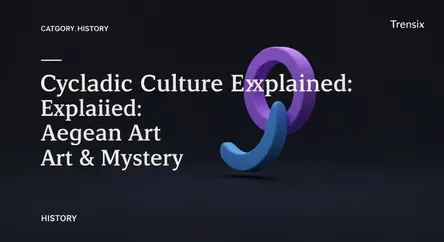History
Cycladic Culture Explained: Aegean Art & Mystery

Discover the Cycladic culture, an early Bronze Age civilization in the Aegean Sea known for its enigmatic, minimalist marble figurines.
What is it?
Cycladic culture was a significant Early Bronze Age civilization that flourished in the Cyclades, a group of islands in the Aegean Sea, from approximately 3200 to 1050 BCE. It is renowned for its distinctive and enigmatic art, most notably the sleek, minimalist figurines carved from the high-quality local white marble. These figures, typically depicting nude females with folded arms, are celebrated for their geometric abstraction and simple, smoothed forms. Alongside these iconic sculptures, the culture produced decorated pottery, metalwork, and stone vessels. Cycladic society was maritime, with evidence suggesting islanders were skilled sailors engaged in fishing and trade throughout the Aegean.
Why is it trending?
The allure of Cycladic culture persists today, largely due to the timeless appeal of its art. The abstract and minimalist nature of Cycladic sculptures heavily influenced modern artists of the 20th century, including Constantin Brancusi, Amedeo Modigliani, and Henry Moore. This connection to modern art has elevated the artifacts from purely historical objects to celebrated works of art, making them highly coveted by museums and collectors. The mystery surrounding the exact purpose and meaning of the figurines—whether they were religious idols, fertility symbols, or something else entirely—continues to fuel academic research and public fascination.
How does it affect people?
The legacy of Cycladic culture affects people by providing a window into a formative period of Aegean civilization, which predates the more famous Minoan and Mycenaean cultures. For historians and archaeologists, the artifacts offer clues about Bronze Age beliefs, burial customs, and societal structures, although the extensive looting of sites has complicated research. For the public, Cycladic art serves as a powerful example of early artistic expression, with its clean lines and abstract forms resonating with contemporary aesthetic sensibilities. Museums exhibiting these pieces allow people to connect with a mysterious and ancient past, sparking curiosity about the origins of art and ritual in the Western world.